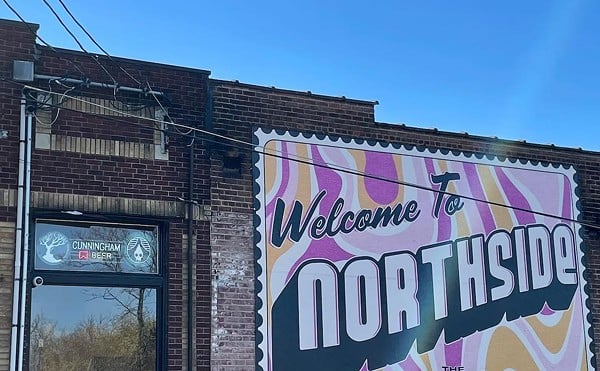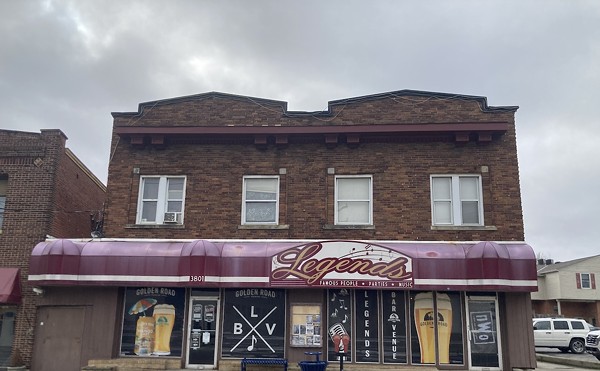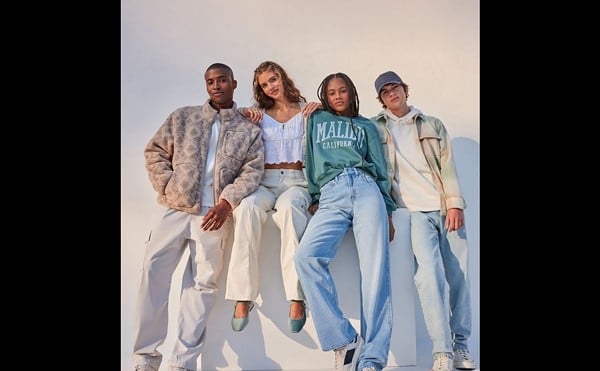“Get in your car, brother, and get down with the people in Cincinnati. A gathering of the people. Celebrate the beginning rites of Summer with the spirits of the Sun, Sky, and Stars.” — from the press release for the Cincinnati Summer Pop Festival, June 1970
On the Saturday afternoon of June 13, 1970, a documentary was playing at the air-conditioned Albee Theatre on Fountain Square in downtown Cincinnati. It was the film Woodstock, which depicted the coming together of a new generation of Rock fans and Rock musicians. On that same humid afternoon a similar music gathering was happening just a couple of miles away.
The Cincinnati Summer Pop Festival didn’t take place on a farm, but rather at a ballpark in the West End. At Crosley Field, home of the Cincinnati Reds since 1912, 14 Rock bands played a daylong festival. With new bands like Grand Funk Railroad, Alice Cooper, Bob Seger, Mountain and Iggy Pop and the Stooges, the performers didn’t reflect the Age of Aquarius but of what was coming for Rock music in the new decade of the 1970s.
The main promoters of the event were Mike Quatro and Russ Gibb from Detroit, which explains the heavy roster of Michigan bands, although there were some British bands on the bill: Mott the Hoople, Ten Years After and headliners Traffic featuring Steve Winwood.
Gibb explains, “At this point I had been staging Rock festivals throughout Michigan for several years and was expanding into other cities.”
This led to the partnering with A. Jaye Agency, located on 116 Calhoun St. in Clifton, to bring a festival to the Queen City. Started by Stan Hertzman in 1967, the booking agency’s stated goal was “to bring good entertainment to campuses, clubs and organizations.”
Hertzman knew a lot about the music business. He’d been in the popular Cincinnati mid-’60s garage band Them, who had done some recording at King Records and had a regular TV gig on Between Time, a teen-oriented variety show on WCPO. Hertzman later managed Adrian Belew, psychodots and The Greenhornes.
The first partnership of Quatro and Gibb with the A. Jaye Agency resulted in a 12-hour Rock marathon at Cincinnati Gardens on March 26, 1970. It was a great success, attracting 11,500 people at $5 a head despite it being on a Thursday and headliner Joe Cocker failing to perform. Ray Lehemkul, who worked at A. Jaye, still refers to Cocker as “No Show Joe.”
“He apparently missed his flight,” Lehemkul says.
Quatro and Gibb brought in headlight acts like the MC5, Amboy Dukes (with teenager Ted Nugent) and British band Savoy Brown. Meanwhile, Hertzman and Lehemkul filled the bill with popular local bands like Balderdash, Whale Feathers and Bitter Blood Street Theatre. The success of the March festival led to the idea of a bigger event at a bigger venue for the coming summer.
What made the June event unique among other festivals at the time was that it brought the Rock festival experience into the living rooms of America. The 14-hour show wasn’t broadcast live but rather edited down to a 90-minute program that aired on national television in late August to good ratings. WLWT (Channel 5) filmed the entire festival with a five-camera crew. Bill Spiegel, a TV producer at the station, remembered how he got in involved in the project.
“Some guy, I think from New York, showed up in a big limo one day and talked up the big money that could be made,” he recalls.
Spiegel and director Bill Health had the lot of experience with music because they both oversaw the production of the long-running TV music program The Midwestern Hayride. Spiegel’s relationship with the Reds secured Crosley Field, and WLWT had been broadcasting the games there for years.
‘All the advantages of Woodstock without the hassles’
Like many events of this kind, there were some problems. First was the delay of the festival.
Originally scheduled to begin at 10 a.m., the start time was already delayed to noon by the time the gates opened about 9:30 a.m. People traveled from Indiana, Kentucky, Michigan, Pennsylvania and other parts of Ohio to camp out overnight by the main gate in the rain, huddled together on blankets and covered by huge plastic tarpaulins. The gathering of the massive yet rather docile crowd delayed trucks carrying equipment and performers from getting inside to set up. It stopped raining around 10.
At 11:30 a.m. the stands were three-fourths full when the police closed all the gates and refused to admit any more people. The shutdown was due to several hundred fans who tried to rush the gate. A dozen tried unsuccessfully to scale the right field wall to sneak in.
Some youths began throwing rocks and bottles over the fence to the crowd inside. Three were arrested in the commotion. Inside the ballpark, however, there were few problems and the festival began at noon.
All festivals have events that everyone remembers. At Woodstock it was the rainstorms. At the Cincinnati Summer Pop Festival it was the battle for the infield.
With the bandstand erected over second base, the Reds organization was concerned about potential damage to the grass area inside the baselines. There were only a few games left to be played at Crosley, with the Reds scheduled to evacuate the ballpark 11 days later. They were to start playing at the new Riverfront Stadium June 30.
Francis Dale, president of the Reds, insisted the concertgoers on the field be restricted to standing on the base paths.
“The city has an obligation to provide us with a major league field in good repair,” he said before the concert. “They will have to bear the expense of repairs unless the promoter’s contract covered such damage.”
Dale said he was worried that newly-laid turf could be responsible for injuries to ball players. Twenty uniformed policemen guarded the infield grass.
The first rush happened after 3 p.m. when the hard-rocking Grand Funk Railroad put on a high-energy set. The police were no longer able to restrain the dancing crowd. The officers held their ground, but the young people merely walked around them onto the field. The show was stopped until the infield was cleared, which was accomplished through pleas from the performers.
What could have led to trouble became only a minor incident through the cooperation of the police and the young fans. There were no arrests and few hard feelings.
Tom Weschler, as part of Bob Seger’s road crew, remembers the infield conflict well. An avid photographer, he took a photo of the infield situation from the stage.
Another shot he snapped that day was of a smiling Seger on stage at the festival with the crowd behind him, and the photo ended up as the back cover of Seger’s next album, Mongrel, released just a couple of months later in August. Weschler has just put out a book of his Seger photos taken over the decades called Travelin’ Man: On the Road and Behind the Scenes with Bob Seger, and it contains photos from the Cincinnati festival.
‘Bring blankets, pillows, watermelon, incense, ozone rice, your old lady, babies, and other assorted goodies and do your own thing’ (from the festival’s promotional flyer, pictured above)
It was the days when you could bring your own stuff to a concert. People brought soft drinks, potato chips, sandwiches, lunch boxes and beer coolers. Iggy Pop brought peanut butter.
Without a doubt, the one contribution that the Cincinnati Summer Pop Festival gave to Rock history was capturing on film for posterity the performance of a young Iggy Pop and the Stooges, the godfathers of Punk Rock.
The footage shot by WLWT cameras shows Iggy, then 23, performing the songs “T.V. Eye” and “1970.” He dives into the audience, gets lifted by the crowd and then stands upright, held up by a sea of hands. He’s shirtless with his taut muscles exposed to TV viewers and every face on the field turned toward him.
Iggy later said at that moment he thought that possibly he was Jesus Christ. The next moment, Iggy received a large jar from an audience member and proceeded to smear peanut butter all over his bare chest and face, then threw huge globs of the jar contents out into the crowd.
The Stooges’ record company would later distribute photos from the performance, and it remains the defining image of Iggy Pop. (Check out Steven Rosen's story "Pop Goes Cincinnati" for more about the 1970 music festival and a look at Iggy's famous photo.)
The late Stooges guitarist John Asheton had a different memory of their set: “All I remember from that was the big video camera guy didn’t care about anyone on stage. I had to follow him, his wires were hooked up to my lead cords, and he’s dragging my fuzz tone and wah all across the stage. For me that was a pain in the ass.”
Another notorious Rock moment documented for the nation’s viewing happened during Alice Cooper’s performance. Cooper leaned down close to the edge of the stage, holding up a pocket watch to the crowd. He began attempts to “hypnotize” audience members, repeating the phrase “Bodies … need … rest.”
At that moment an accomplished marksman in the crowd lobbed a whole cake at Cooper, hitting him square in the face. Maintaining his cool, Cooper proceeded to take a handful of the cake and slap it right back into his own face. Again and again he repeated the gesture, smearing it in good.
Despite the large presence of police, there was marijuana smoke in the air and pills being passed around in the stands. Several arrests were made, but for the most part both sides remained friendly.
There were a few bad trips. Two girls showed up at the First Aid station looking for a friend who’d taken too much acid and wandered away from them. They would later track him down at Christ Hospital.
Most problems the First Aid station dealt with that day were foot injuries and heat exhaustion from the crowded condition on the field. Many of the men went shirtless to keep cool.
The crowd’s fashion taste included tie-dyed T-shirts, mini shorts and cut-off jeans. By nightfall the crowd had mellowed, with some men tossing frisbees.
Steve Winwood and Traffic put on a great performance, with the camera crew again capturing another rarely-filmed band. The festival ended promptly at midnight.
‘Rock Fest in Cincinnati is $$ Success, but Rocked by Melee’
That was the headline of the July 4, 1970, article in Billboard magazine. “It’s not likely that staid Cincinnati will welcome such an attraction soon again,” the article stated. “Not that it wasn’t a success financially — it was, and big.”
Quatro, the main promoter, is quoted in the article as saying the event attracted an estimated 24,000 people at $6.50 a head. Many came from surrounding states. Billboard pointed out that the program itself ran relatively smoothly but that there were “numerous incidents engineered by a minority hoodlum element that unsettled the event and soured public opinion.”
The article also noted that the local TV stations aired featured footage depicting the lurid details. The police department had 110 men assigned to the event, which Quatro funded.
The big rumble came shortly after the close of the show at midnight, when the article said 74 arrests were made. According to the report, “Police had to use force to control youths who hurled bottles and rocks. 12 rock fans that resisted arrest were given hospital treatment. A number of police were injured. Nine required hospital treatment.”
Local newspapers reported that most of those arrested were from Michigan. About a dozen were from Ohio, with two each from Pennsylvania and Indiana. Most spent the night in jail unable to raise bail. The majority of those arrested said they were under 21 years old.
Damage to Crosley Field facilities was estimated at about $6,000. Seven police cars and a patrol wagon were damaged by youths throwing rocks and bottles.
The Reds’ last game at Crosley Field was played on June 24, 1970, against the San Francisco Giants. The city turned the old park into an auxiliary auto impound lot. On April 19, 1972, Pete Rose Jr. pulled the lever that released the wrecking ball into side of Crosley Field.
Lehmkuh and Gibb are retired form the music business. Quatro continues to promote musical acts in the Detrot area. Hetzman books bands at his leisure at Awakenings in Hyde Park. And Iggy Pop and The Stooges were finally inducted into the Rock and Roll Hall of Fame this year.
Celebrate the 40th anniversary of the CINCINNATI SUMMER POP FESTIVAL at the 1:30 p.m. screening of the rarely-seen documentary Midsummer Rock at the Main Public Library Branch downtown. A panel discussion will follow the screening with promoters Ray Lehmkuh and Stan Hertzman, Bill Spiegel (WLWT producer and executive producer of the documentary Midsummer Rock) and Tom Weschler, Bob Seger’s road manager and author of Travelin’ Man: On the Road and Behind the Scenes with Bob Seger.>
Get more info about the 1970 music festival, particularly Iggy Pop's role, in Steven Rosen's article "Pop Goes Cincinnati."





